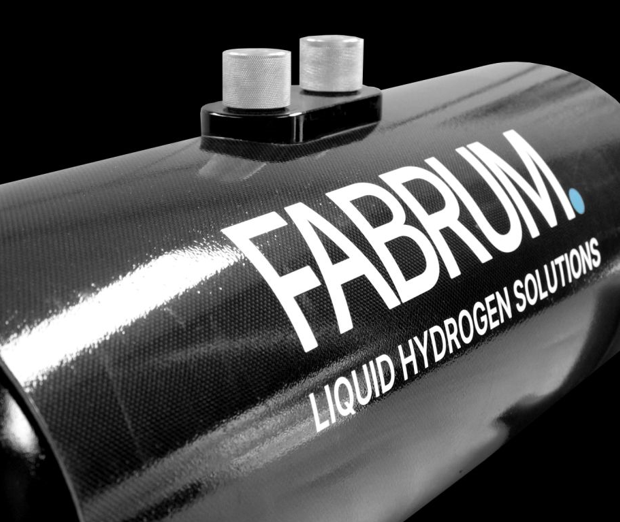
Co-Founder and Technical Director – Hugh Reynolds
Fabrum’s pioneering liquid hydrogen technology could help create a net zero carbon air industry
As a driver, you can buy a battery electric car and immediately make a dramatic reduction in your carbon footprint. But decarbonising other aspects of the global transportation economy is much harder. For long-distance travel and freight, electric batteries become less practical – and that’s when hydrogen starts to shine.
“Batteries create a weight penalty that cuts into your available payload,” explains Hugh Reynolds, Co-Founder and Technical Director at Fabrum. “You might lose 50% of the available payload by using batteries. In this type of situation, hydrogen is the fuel you need. For a train or a commercial vehicle that’s being driven 12 hours a day, hydrogen gives you the range and power output that you can’t get from a battery.”
Fabrum has been working on hydrogen solutions in the commercial transport and mining sectors for some time. These large land-based projects are enormously promising for decarbonising long-distance trucking and industrial-scale mining. Plus, they provide proof of value for an even more ambitious goal: hydrogen-fuelled aviation.
Why hydrogen is the aviation fuel of the future
The airline industry is worth $3.5 trillion dollars, making up over 4% of the world’s GDP. But it also accounts for over 2% of energy-related CO2 emissions and is not on track to achieve net zero emissions by 2050.
Decarbonising the aviation sector will require massive investment and innovation – and the most promising alternative fuel is green hydrogen.
Liquid hydrogen has been NASA’s fuel of choice for space exploration since the 1940s, because it is the most efficient rocket propellant available. The technical challenges are huge, but the payoff is worth the effort. Liquid hydrogen is an extremely light and powerful fuel, and NASA says that taming this technology is one of its most significant technical accomplishments.
The same benefits are what makes hydrogen the most practical choice for decarbonising aviation, says Reynolds:
“The light weight of hydrogen offsets the additional costs – that’s why space shuttles are fuelled with hydrogen. Our large-scale liquid hydrogen for heavy mining applications have helped prove the technology on the ground, and now we’ve testing liquid hydrogen fuel systems for aircraft.”
Megawatt-scale hydrogen aviation within the next 12 months
Last year, Fabrum and five other international businesses formed a consortium that aims to bring zero-emissions aviation to life. The group includes Airbus, Fortescue Future Industries, Air New Zealand, Christchurch Airport and Hiringa – all organisations at the forefront of innovative green energy adoption.
Although hydrogen-powered planes are beginning to be successfully tested on land and make some short exploratory flights, none are yet ready for commercial use in passenger or freight aircraft. But Reynolds says Fabrum is on track to deliver next-generation hydrogen aviation technology within a year:
“I believe we’re about 12 months away from heavy megawatt-scale systems for planes fuelled by liquid hydrogen. We are working to produce light and reliable liquid hydrogen tanks for aircraft, and we’ve developed technology that then distributes that liquid hydrogen, warms it up and feeds it to fuel cells to power an aircraft.”
But hydrogen-fuelled aviation requires much more than just a way to store the fuel on board an aircraft. It needs the development of an entire hydrogen ecosystem, and Fabrum is well-positioned to supply the technical expertise and products to support this new green energy economy.
Building an end-to-end hydrogen economy
Fabrum’s extended ecosystem of hydrogen products has attracted international attention last year, with a $23 million investment from strategic global organisations and a major electrolyser manufacturing agreement with a UK partner.
“We see hydrogen being very dominant in our business plan,” Reynolds say. “First, as a gas system, creating small-to-medium scale liquid hydrogen systems. Then we have our electrolyser innovations, which make green hydrogen cheaper and more efficient to produce, with a whole lot of benefits that are pretty amazing for an electrolyser. And we are also experienced in manufacturing cryogenic storage vessels for liquid hydrogen, dispensing that liquid, and creating fuel stations.”
All of these innovations take a considerable investment of time and money, and although Reynolds is optimistic about the future, he doesn’t want to give the impression that a magic fix is just around the corner. There are still considerable challenges ahead if the world is to reach its emissions targets and fight climate change.
“I think people should feel positive, but I don’t want anyone to become complacent and think they can sit back and do nothing,” he says. “We need to work on the basis that everyone has to do their little bit – and we’re doing ours.”
